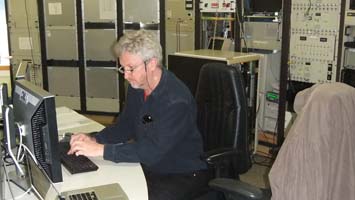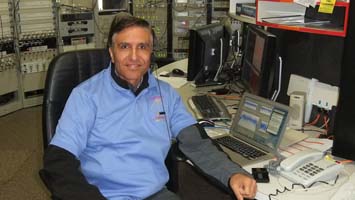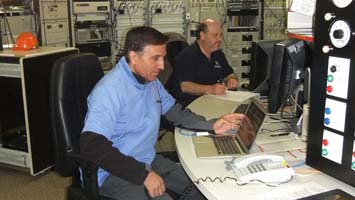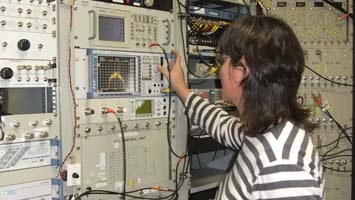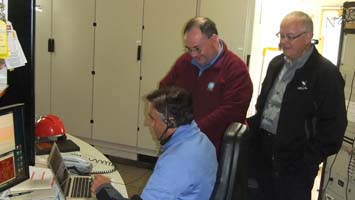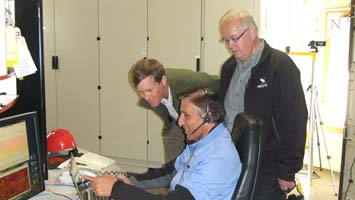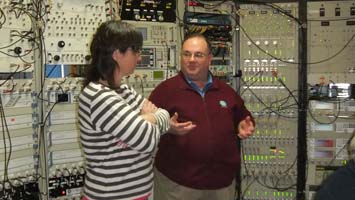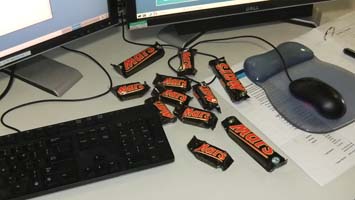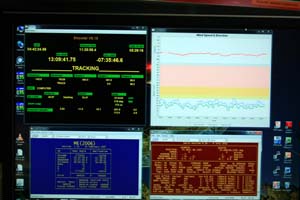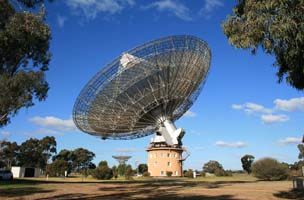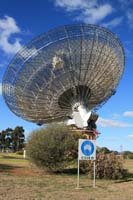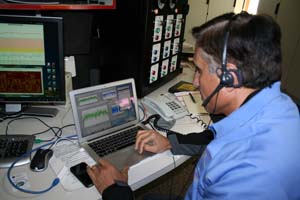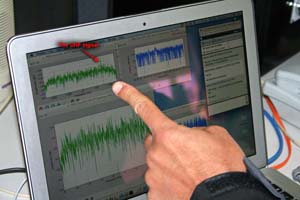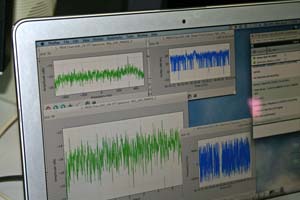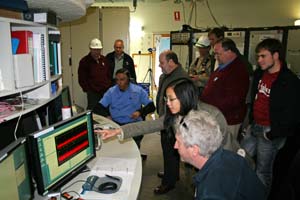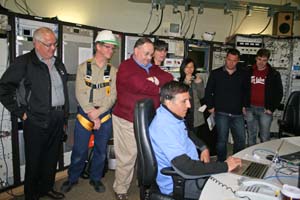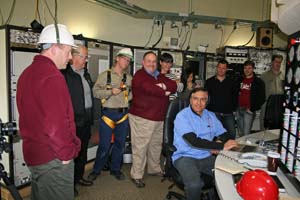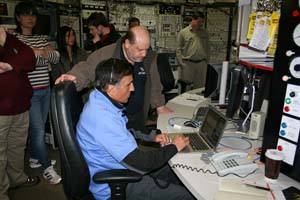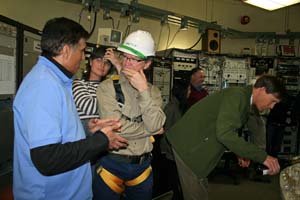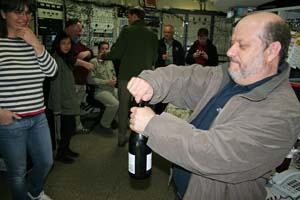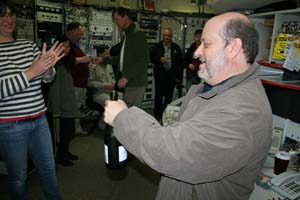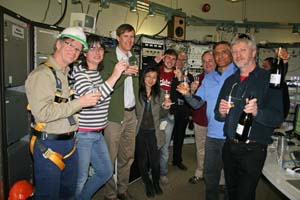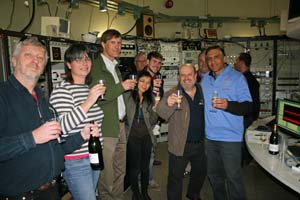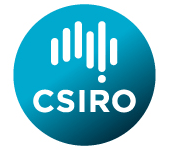 |
The Parkes MSL EDL Track
6 August 2012 |
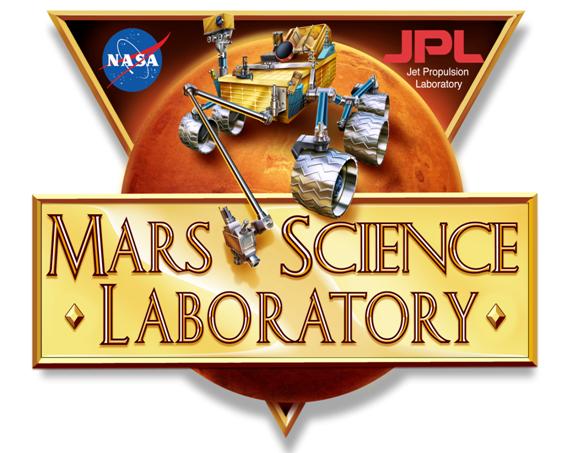 |
|
On Monday, 6 August 2012, at 3:31 PM (AEST), the Mars Science Laboratory rover, Curiosity, safely landed on Mars. The CSIRO's Parkes telescope was tracking the rover's UHF beacon during the Entry, Descent and Landing (EDL). Right on schedule at 3:16 PM (AEST) the signal was detected. It was slightly stronger than expected. Parkes tracked the descent of the rover until just after the parachute deployment and heat-shield separation. Less than two minutes before it was scheduled to land, it dropped below the Martian horizon, out of sight of Earth, at 3:30 PM (AEST). Throughout the descent, Parkes was acting as a backup for the Canberra Deep Space Communication Complex (CDSCC) at Tidbinbilla in the ACT, which was the prime station for the mission.
On the day, everything at Parkes came together beautifully. All the equipment performed flawlessly and the months of planning and preparation paid off. Congratulations to all the CSIRO Astronomy and Space Science (CASS) staff who worked so hard to make the support such a great success. It was a magnificent team effort. The following pictures tell the story of the CSIRO Parkes Observatory's support of the MSL EDL.
|
Click on the images to view the larger versions
(All images © provided courtesy of John Sarkissian unless stated otherwise)
Prelude
On Sunday, 5 August, a late afternoon rainfall produced a double rainbow over The DISH.
It was a promising start, inspiring confidence in the following day.
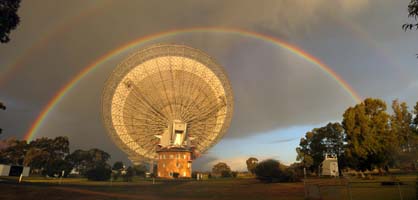
© Image courtesy of Alessandro Ridolfi
Pre-Track Preparations
|
In order to support the mission, an existing 70cm radio astronomy receiver was modified by CASS engineers and technical staff. In January, Brett Armstrong and Mal Smith characterised the old receiver at Parkes and it was concluded that it needed to be significantly upgraded. Suzy Jackson and Alex Dunning, at our receiver labs in Marsfield, Sydney, successfully upgraded the receiver and modified the feed to operate at the slightly lower UHF frequencies employed by the rover. The receiver was delivered to Parkes and installed in the focus cabin on 5 June 2012. Over the following two days, tests were conducted to characterise its performance. To the delight of everyone, the receiver performed as expected, although significant RFI issues were identified. Over the next two months, RFI mitigation and avoidance strategies were devised and put into place that significantly improved the passband. In addition, a detailed risk assessment was prepared to identify potential problems that could threaten the successful completion of the track.
Two weeks before the EDL, the Radio Science Receiver (RSR) was delivered to Parkes from Tidbinbilla and installed in the control room by Brett Preisig. With the assistance of Dr Shaun Amy, the ethernet links to the RSR were established. The receiver was re-installed on Tuesday, 31 July. A test track of the MER Opportunity rover was conducted that evening to verify that we could receive a UHF signal from Mars and process it correctly with the RSR. Click here for more information on this test. Over the next few days, CASS staffers Dr Ettore Carretti, Dr Stacy Mader, Suzy Jackson, Brett Preisig and John Sarkissian worked to further characterise the UHF receiver and to identify and eliminate the known sources of RFI that might disrupt the signal reception.
Around mid-day on the day of the track, Dr John Reynolds, with Dr Chris Phillips in Sydney, setup the VLBI DAS to record the signals as a backup to the JPL Radio Science Receiver (RSR). Meanwhile, JPL's Sami Asmar, confirmed that the RSR was functioning correctly and that the radio science crew back at JPL could communicate with it. Brett Preisig and Suzy Jackson went up to the focus cabin and turned off any unnecessary monitoring equipment and added absorbers to the electronics cabinets to further minimise RFI. At 1:29 PM (AEST) John Sarkissian drove the dish to Mars in preparation for the signal reception. As the track progressed, the wind picked up and threatened to stow the telescope. But luckily the wind held off and eventually subsided.
Other CASS staff were on hand in the control room to assist in case anything went wrong. They included Dr Douglas Bock (ATNF Assistant Director for Operations), Erik Lensson (ATNF Head of Engineering Operations), Dr Shaun Amy (Manager of ATNF Computing Infrastructure), Mal Smith (Parkes Observatory Site Manager) and Parkes technical staff, Tim Ruckley and Daniel Craig. Other staff were elsewhere on site monitoring the power supply and other systems. Parkes observers, Alessandro Ridolfi and Cherry Ng, came along for the ride.
At Parkes, we made sure we had an ample supply of Mars bars (chocolate coated nougats) as a hat tip to JPL's tradition of passing around peanuts for good luck.
|
The Dish tracking Mars just minutes before the reception of the UHF signal from Curiosity.
The Entry, Descent and Landing (EDL)
|
With everyone gathered around the monitors, we waited for the signal reception. Right on schedule, at 3:15 PM (AEST), the cruise stage separated and then a minute later at 3:16 PM, the UHF beacon appeared in the passband of the RSR data. The signal was strong, which gave us confidence that the spacecraft was operating as expected. As the spacecraft continued the descent, we could see the signal being Doppler shifted in the plots produced by Stephan Esterhuizen at JPL. The parachute deployment and heat-shield separation were clearly evident on the plots. The Parkes loss of signal (LOS) occurred at 3:30 PM (AEST) as the spacecraft was occulted by Mars. Less than two minutes later, Sami reported that Curiosity had landed safely. A cheer went up in the control room. Within a few minutes, the first pictures from the rover on the Martian surface were received at Tidbinbilla, confirming that the landing was a total success. This was the cue for our team to pop open the champagne. We toasted the success of the mission and congratulated NASA, JPL and the CSIRO crews at Tidbinbilla and Parkes for jobs well done.
A few days earlier, Dr Phil Diamond, the Chief of CASS, had stated; "The expertise of Australian personnel in space communications and CSIRO's partnership with NASA will be showcased during this critical event in the Mars Science Laboratory's mission. All of our technology and our people are ready." Indeed, it was an amazing achievement.
|
The UHF signal received at Parkes
|
This plot was kindly provided by Sami Asmar operating the Radio Science Receiver system at Parkes and processed by Stephan Esterhuizen at JPL. It shows the Doppler shifted signal as a function of time for the entire Parkes track. The "squiggles" in the signal are likely related to the parachute deployment and heat shield separation. It contains lots of priceless information waiting for detailed analysis. For example, the faint diagonal line to the left of the main signal is likely a bi-static reflection of the UHF signal off the surface of Mars.
|
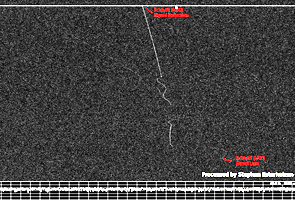
The DISH in 3D
To see the dish tracking Mars in 3D, cross your eyes, merge the Mars globes, and look down to see the dish in stereo.
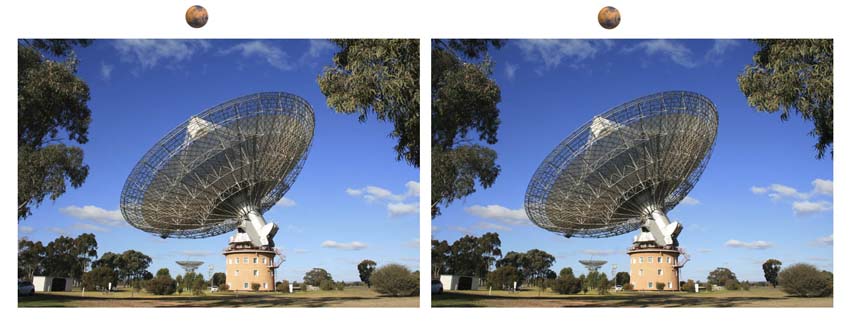
Post Script
|
In January 2005, during the Huygens probe's descent through the atmosphere of Saturn's largest moon, Titan, Sami Asmar was at the Greenbank Observatory tracking the S-band beacon from Huygens for the first half of JPL's Doppler Wind Experiment (DWE). Meanwhile, John Reynolds was at Parkes observing the second half of the DWE. For this mission to Mars, both Sami and John were now together. An interesting symmetry was that both Saturn and Mars were converging near Spica in the best planetary conjunction of the year.
|
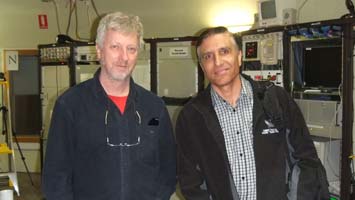 |
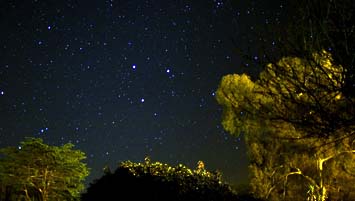 |
| Mars is below and Saturn is on the upper right
© Images provided courtesy of Tony Trelford |
|




